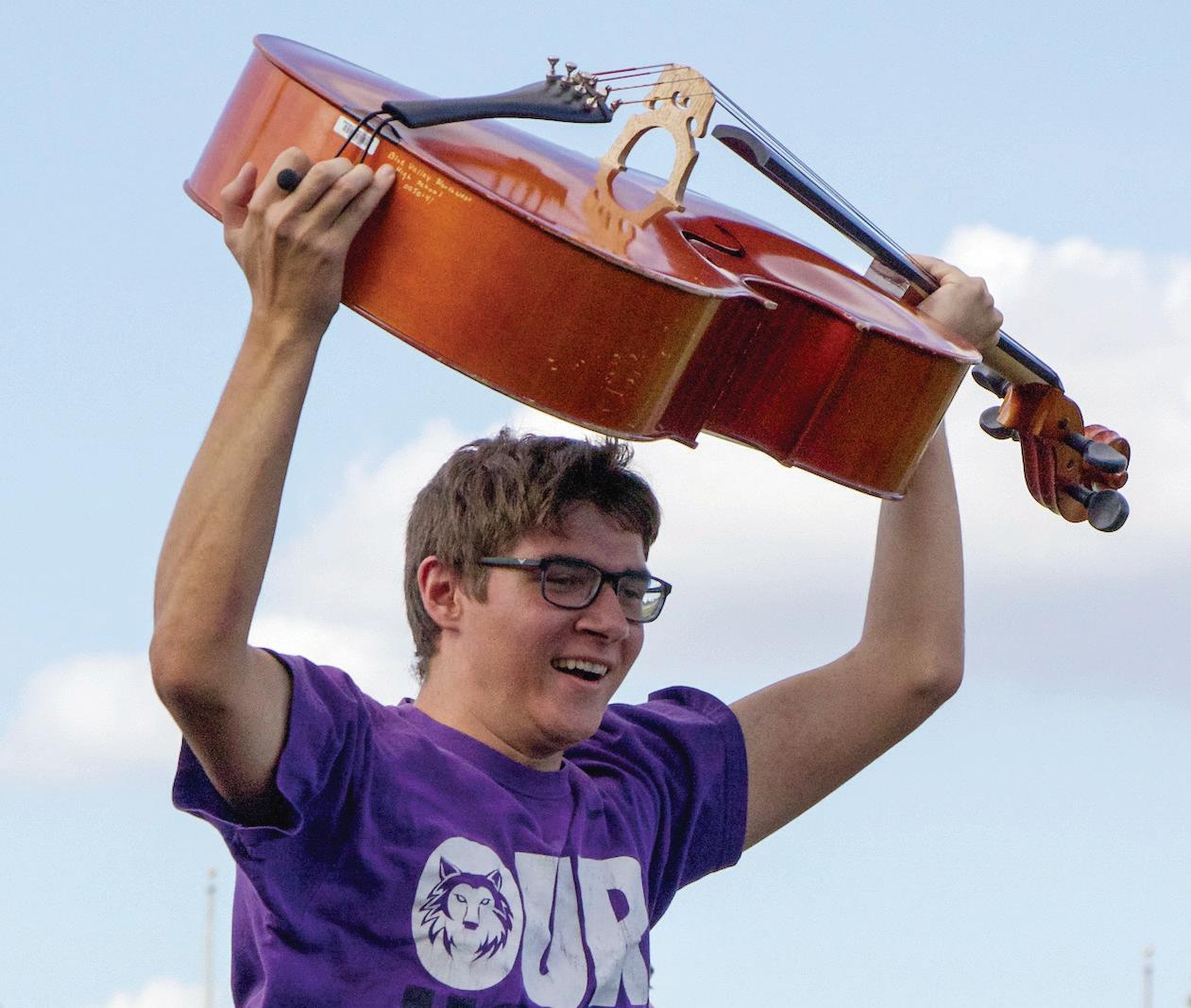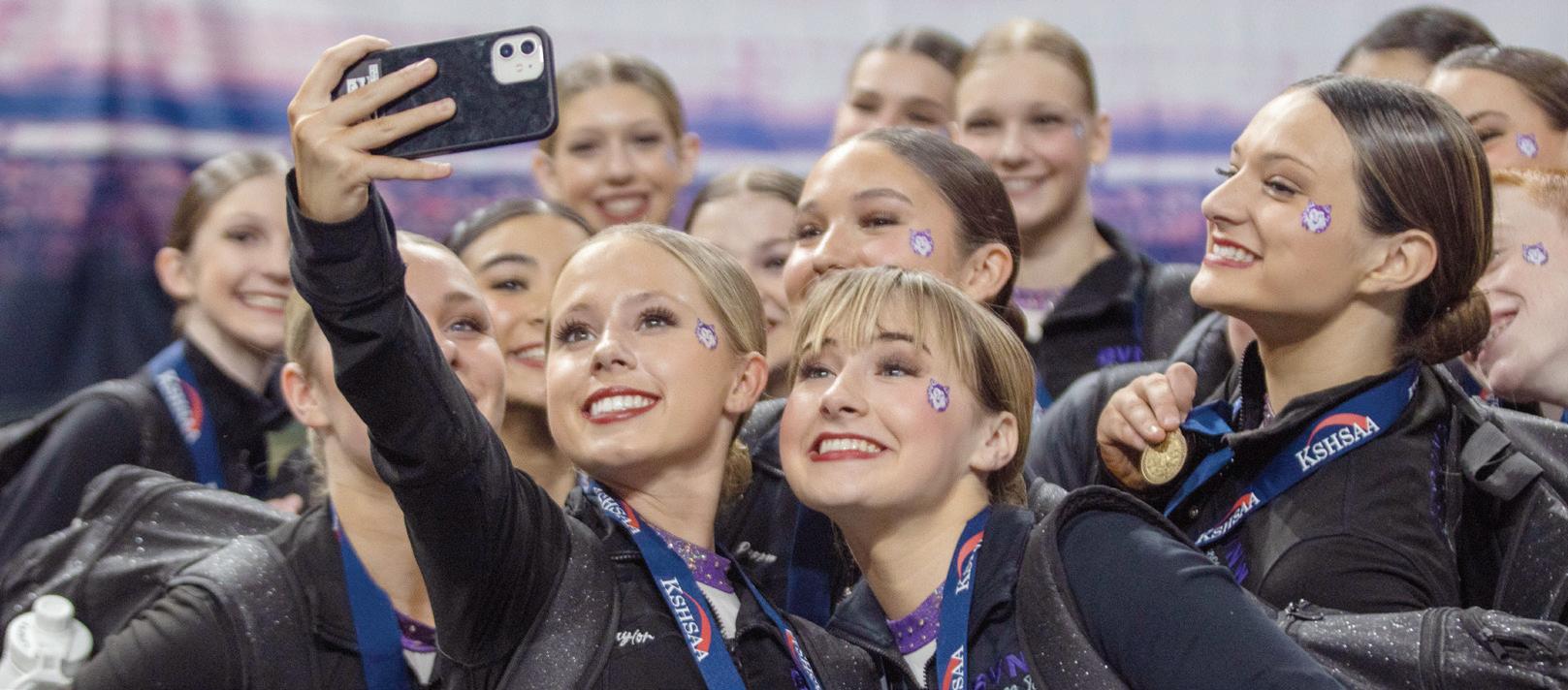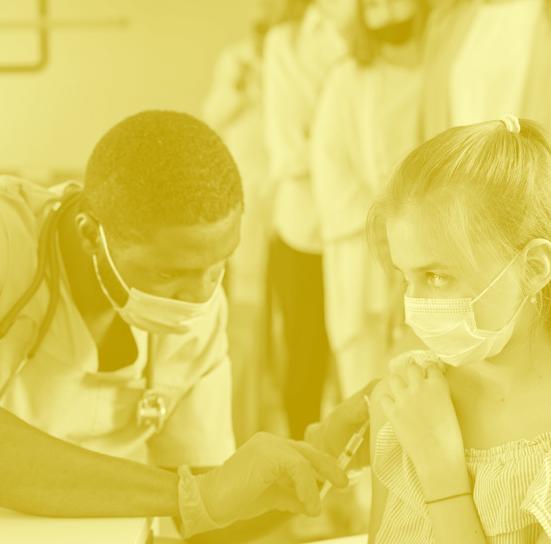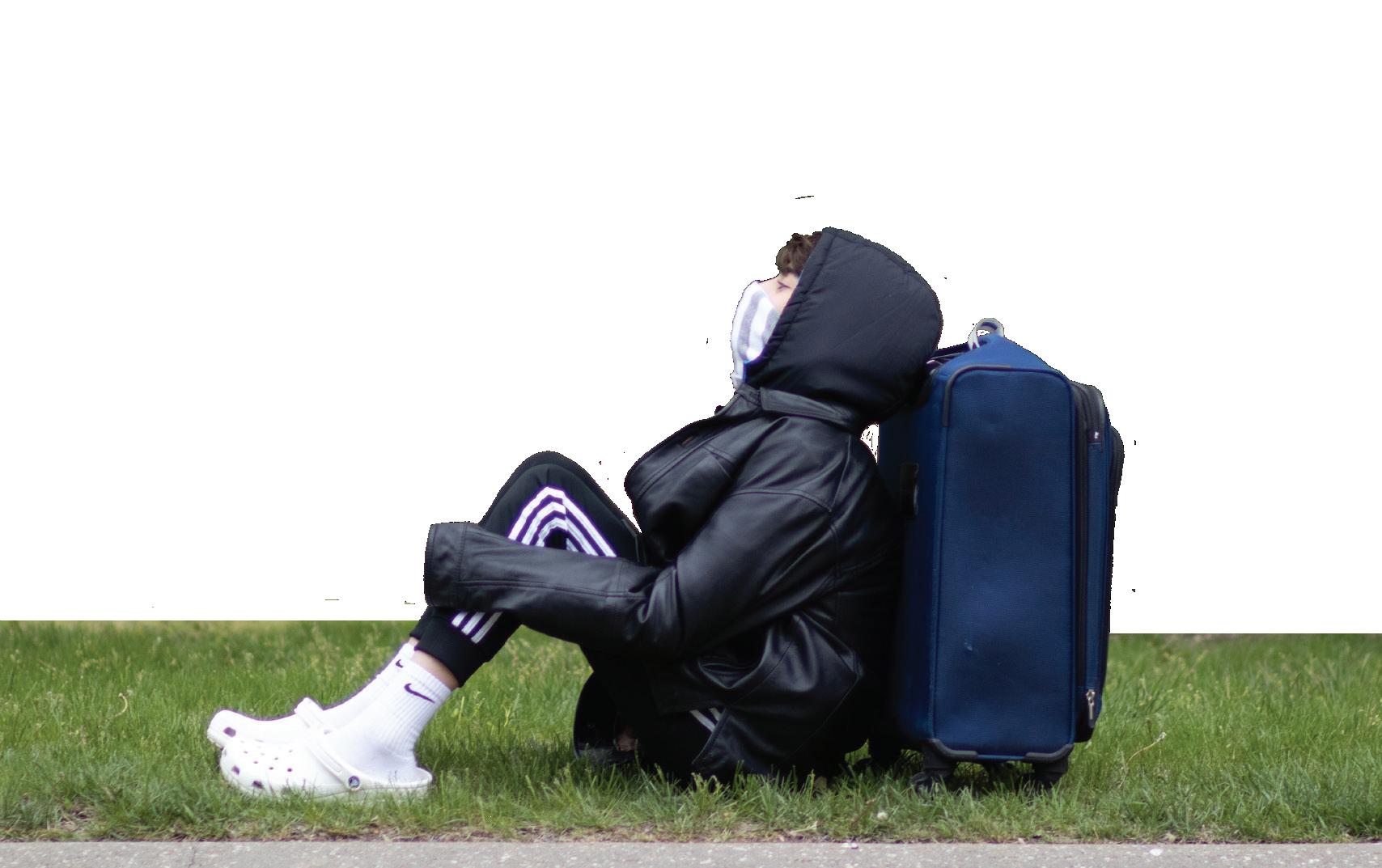FILLING THE GAP
Generational gaps and differences must be acknowledged for people to understand one another PAGE

VOLUME 30 • ISSUE 8 • BLUE VALLEY NORTHWEST
12
TH E E X PRES S
A reflection of how school security can be improved in wake of recent school shootings.


02 | THE EXPRESS CONTENTS CONTENTS FEATURES
habits is
to avoid being
by addictions. The Illusion of Money The Balancing Act Prevent to Protect 27 19 EDITORIAL OPINION OPINION The Generational Divide Crime Cycle It’s Time to Measure Up 4 6 7 Finding Home 24
in
Pursuing a financially sustainable yet fulfilling career is a struggle many grapple with. Balancing
crucial
controlled
Home instability is a relevant yet underdiscussed problem
Blue Valley.
8
Filling the Gap
Members of each generation seem to be shaped by their environment, thus creating stereotypes of that age group. Senior Brooke Farrington said she has noticed such stereotypes in older generations. “I feel like some pretty obvious stereotypes of older generations are that they’re more conservative [and] traditional, like in the way they think that people should dress or act,” Brooke said. “They really want everybody to fit the mold, instead of kind of creating their own.”
Game Day Gallery 22 10 30
Coast to Coast A Year In Photos

MAY 2023 | 03
CONTENTS
A map of the various colleges seniors are attending after high school.
A recap of photos from the 20222023 school year.
ON THE COVER A&E
Photos from girls swim, girls soccer, boys golf, softball and track.
12
The Generational Divide

We have all experienced those Thanksgiving dinners when Grandpa is saying something just a little outdated, our parents complain about how our phone usage is frying our brains, while you drone on about all the injustices in the world. That pretty much sums up the tension between generations.
This tension is even evident in our memes. In 2020, we had the “OK boomer” meme. More recently, millennials have been under fire for their “outdated humor” and side-parted hair.
Instead of immediately defining one generation as one thing, we need to look into what shaped its trends, humor and opinions. There are many different truths in any given situation, especially on a generational basis.
For example, Gen Z is more likely to lean politically progressive whereas baby boomers tend to be more conservative. Each generation has its own ideas on what problems need to be
fixed, like the economy or social justice issues, and how to fix them.
Some are able to look past the differences between generations and understand that our environment is what shaped our thinking. Massive worldwide events help mold generational perspectives. Your grandparents may be a product of the Vietnam War. Our parents feel defined by 9/11. The rise of social media and COVID-19 weigh heavily on our generation.
Just because someone of a different generation has a different opinion than you does not mean it should be disrespected. It is essential for not only our generation but the generations above us as well, to listen to each other so we can better understand what shapes generations. The more open we all are to one another, the better.
04 | THE EXPRESS EDITORIAL






MAY 2023 | 05 ADS
Yafa Cafe
CRIME CYCLE
Written by Lizzie Lively, Designed by Julia Moser

Our prison system is inherently broken. The problem is not that there is a lack of prisons; it is that there are too many. The percent of incarcerated people in the United States seems small: 0.7 percent. But in context, that is over two million people. The U.S. also has the highest number of people in prison, as well as the highest incarceration rate, out of any other country. Something is very, very wrong here.
Our current system uses methods of punishment and deterrence. The threat of punishment supposedly deters people from committing crimes. But in our society, where poverty and mental health problems are rampant, deterrence is an ineffective method.
The Department of Justice even has an article stating that this method is useless and that “prison sentences (particularly long sentences) are unlikely to deter future crime.”
What prisons create, instead, is a vicious cycle of crime called recidivism. People will get arrested for a crime, and then they will go to prison. When they get out of prison, they have nothing. Then, they cannot get a job because employers tend to turn away former convicts, so they turn back to crime to keep bills paid. An Iowa State University study found a prior conviction increased the likelihood of a repeat offense massively. For robbery offenses, chances increased by 294 percent. For drug sale offenses, 736 percent.
Additionally, the prison system and problems within the police force disproportionately affect people of color, specifically Black people. We have all heard the terrible racist stereotypes:
“Black people are violent.”
“Mexicans are drug dealers.”
These stereotypes have a real effect on the way people of color are incarcerated. The Sentencing Project found Black people are incarcerated at five times the rate that white people are. It also found that Latino people are incarcerated at 1.3 times the rate that white people are.
For more context, as of July 2021, the U.S. Census Bureau found people of color make up approximately 25 percent of our population outside of prisons. The Federal Bureau of Prisons found that 42.5 percent of the prison
population were people of color, with Black people alone making up a little over 38 percent of the population. That is a huge disparity.
Our country has a massive problem with mass incarceration. Former President Ronald Reagan, may he (not) rest in peace, was an explosive force in this. The U.S. Department of Justice reported the prison population nearly doubled during Reagan’s time in office. Reaganera politicians used thinly veiled racial rhetoric to gain public support for bills that increased incarceration rates to where we are in the present.
Deterrence is not an effective solution; that has been proved many times over. Many people do not commit crimes out of want, but rather out of perceived or real need.
Mental health problems are another significant motive in pushing people to commit crimes, especially drug-related crimes. Even with violent crimes, a lot of people committing them have underdeveloped prefrontal cortexes, leading to aggression and violence.
Mental Health America found 50 million people struggle with mental health problems as of 2020. Additionally, 93.5 percent of Americans with substance use disorders have not received help for their mental illness.
This is because treatment programs are expensive and wildly inaccessible to most Americans. Insurance coverage for mental health providers is hard to find, making access to these providers very expensive and unrealistic for most Americans. Then when people can access these services, the wait is very long. It can be weeks, months or even years before individuals can see their providers.
Mass incarceration is not a crime problem; it is a mental health problem. Our government needs to focus on preventing crime, not putting $80 billion into a prison system that does not work. It only causes more pain in people who are already suffering and very little people in power care about this.
Only eight Democratic politicians had prison reforms as part of their platforms in 2020. I urge you to get vocal. These people need our help. Start making noise about this issue and our politicians will make it part of their platforms. Incarcerating people does nothing to benefit our society; there has to be a better way.
06 | THE EXPRESS OPINION
OPINION
Mass incarceration is not a crime problem, it is a mental health problem.”
- LIZZIE LIVELY
IT’S TIME TO MEASURE UP
Written by Lexington Jones, Designed by Julia Moser

America needs to get on board with the metric measurement system. The two countries besides the U.S. that use the imperial system (inches, feet, etc,), are Myanmar and Liberia. All 195 other countries across the world use the metric system. Honestly, I am slightly embarrassed to live in one of the three countries who are too stubborn to switch systems. The U.S. needs to jump on the bandwagon and do what is best for the education system, economy and future.
Metric is simply a better system of units than imperial. It is a consistent and coherent system of units; it fits together well and calculations are straightforward because it is decimal-oriented. The basic units for length or distance measurements in the imperial system are the inch, foot, yard, and mile. Metric is easy to remember, as the most common three base units are the meter, gram, and liter.
Section 8 of Article I of the U.S Constitution states Congress shall have the power to “fix the standard of weights and measures.” America’s founding fathers had two choices of a measurement system to adopt: the newly-introduced metric system or the traditional British Imperial System. Thomas Jefferson selected the British Imperial System, which has been used for 197 years. Now, the system is out of date and causing the U.S. to fall behind as a majority of the world proceeds with an uncomplicated and modern form of measuring. Whenever the discussion of switching unit systems arose in Congress, the passing of a bill favoring the metric system was vetoed. People believe the United States should keep its current system, setting it apart from other countries and symbolizing its status as a leader rather than a follower.
Supposedly, the biggest reasons the U.S. has not adopted the metric system are time and money. When the American Industrial Revolution began, expensive manufacturing plants became a main source of jobs and consumer products, with everything being measured using the imperial system (IS). The machinery used in these factories was developed to size in IS units. Many products were developed with this measurement system in place and employees were trained to deal with IS units. I think we have come a long way since the Industrial
Revolution, considering back then we did not even have established child labor laws; but that is a whole other issue. In the present day with technology that is way more advanced, a change like this would not be as drastic as it would have been in the late 1700s. Americans have dealt with much scarier situations such as the pandemic or the increasing murder rate, so changing a couple numbers and labels should not be too difficult.
Some argue it would be too expensive to switch our measurement system, but in the long run it is worth the cost. The U.S. will be able to have more efficient transactions and trades with foreign countries. This will open up the opportunity to start new deals with nations we have not done business with before due to complicated differences in measurement and conversions.
I have been taught to measure in the IS system and the metric system. However, in science classes like AP Chemistry, measurements are only done using the metric system. This was quite the adjustment at first because I had been accustomed to ounces, inches, feet and yards. When I was handed a flask and told to measure out 250 mL, I could not even make an estimate of how much that should be. Learning to convert measurements took time away from class that could have been spent doing experiments, or learning something more worthwhile then a system I would only end up using for a year in AP Chemistry.
In modern times, most of America has accepted a joint unit system by teaching children in school both the IS system and the metric system. This is why U.S. measuring sticks, or rulers, often contain both inches and centimeters. By eliminating the IS system and only educating the metric system, future students in America will grow up and carry that common knowledge of measurement across the world. Additionally, students will not need to memorize two systems and learn how to convert units. It will save teachers, and students time and energy. Benefits of being like the rest of the world in our measurement system would increase efficiency in business transactions, travel, education, etc. In the long run, adopting the metric system will make life easier for Americans, and allow our country to be on board with nations across the world.
MAY 2023 | 07 OPINION OPINION O that highest incarceration very, deterrence. people where deterrence that (particularly crime.” called then they employers back study a increased percent.
The U.S. needs to jump on the bandwagon and do what is best for the education system, economy and future.”
- LEXINGTON JONES
ILLU$ION OF MONEY THE
Money and passion conflict when individuals are faced with a career choice.
Written by Bridget Hamlin and Thomas Rose, Photographed by Arpa Das, Designed by Alex Cowdrey
requires.” Trader said some people are chasing this illusion through unsustainable means.
“You don’t even know for sure that the money people are spending is even money that they have,” Trader said. “There’s a lot more people living on loans than we realize.”

enjoy, it›s not worth it,” Scheibel said.
Her family is a direct influence on how she views the value of money. Her mother, Katie Schiebel, explains how she raised her children to view the value of money.
our careers that money is not the end-all be-all, and both of us felt that we were being called [into] very different areas,” Trader said.
She explained that the decision to change careers was not easy, Trader became a teacher and her husband became a firefighter.
“That initial jump of careers was a pretty substantial hit to our budget,” Trader said. “However, we don’t regret it at all. We both are doing things that we know we’re meant to do.”
Senior David Wen explained his perception of the illusion of money and how capitalism affects individuals’ behavior.
“[Capitalism] has led to a massive desire to chase that money, and the culture that’s built up around it can be toxic,” Wen said. “The illusion of money is when you chase the products of money without [being] willing to accept the risks. You want the status and respect having money gives, but not the hard work and talent that getting the money
Trader’s decision to switch careers is one that many Americans face; according to the U.S. Department of Labor. Around a third of the total workforce changes jobs within a year of being hired, with much more of the population switching at less frequent intervals.
In addition, changing one’s field of work after college is becoming increasingly common. A 2022 CNBC article stated 61 percent of all those who changed careers in 2021 chose different fields of work for their new jobs.
For some, the choice is difficult; however, sophomore Sara Schiebel has already determined she wants a career primarily based on passion.
“I think that no matter what the salary is, if it›s something I don’t
“We try to choose time over money. When we make time a priority, it makes our family happy,” Katie said. “We feel like the memories are priceless, especially when we can all be together.”
Sciebel also feels that her family has taught her to prioritize memories.
“I think that my family shows that making memories and having fun is much more valuable than money,”
She goes on to say that the people you surround yourself with determines your happiness.
“I think that money can buy things that can make people happy, but it is not anywhere near the happiness that people can bring,” Scheibel said. “Some people will always want more money, but I think that true happiness is being happy with what you have.”
08 | THE EXPRESS FEATURE
“Some people will always want more money, but I think that true happiness is being happy with what you have.”
-SARA SCHEIBEL
Trader explained her parents also raised her with the perspective that money is not a top priority.
“My parents always challenged us to work where we could do a greater good, and I know I can do more in this setting than where I was, fixated on the bottom line of a corporation,” Trader said. “I wake up excited to do my job, and I would not do that if I had to walk into a cubicle every day.”
Wen said finding joy in a chosen occupation is important to being content with life.
“Chances are, your single largest impact on humanity will be your career,” Wen said. “Whether or not you enjoy your job plays a massive role in happiness.”
Wen explained he was undecided between the University of Texas System, which overtook Yale’s spot in 2018 for the second wealthiest U.S. university, and the University of Michigan, which spends over one billion dollars on research a year. He later decided on the University of Michigan to study nuclear engineering because of the greater access because of the greater access to resources
“[I am] looking at cost of attendance for both schools, which scholarships I could qualify for which school, and which school had the better alumni network,” Wen said.
He said money may be important to reach happiness, but a more substantial factor is discovering a sense of belonging.

“People want to feel like they’re part of something bigger than themselves [and] that their actions will be remembered,” Wen said.
Likewise, Schiebel explained that dedicating yourself to something that matters to you is more important than any salary. .
“I think that you cannot put a price on doing something you love; doing what makes you happy is priceless,” Scheibel said.
“Over 39% of people who are considering career changes are motivated by higher salaries,” according to co-author, Killingsworth Kahneman, of Proceedings of the National Academy of Sciences.
A YEAR IN PHOTOS





10 | THE EXPRESS A YEAR IN PHOTOS
Top Right: Senior Jared Martens runs out with his cello and the orchestra program during Husky Night on Aug. 22. (Photo by Shahd Abdeljalil)
Middle Left: Seniors Adam Koehler and Brett Oplotnik perform in the fall musical, “Catch Me If You Can”, on Nov. 17. (Photo by George Buckley)
Middle Right: Senior Brooke Farrington competes with the cheer squad at a cheer competition on Nov. 12. (Photo by Norah Alasmar)
Right: Senior Grant Stubblefield celebrates with the boy’s basketball team after winning the KSHSAA 6A state title. (Photo by Bailey Thompson)
Top Left: Sophomore Ishika Katukum performs at the diversity assembly on April 20. (Photo by Kendall Dickerson)




MAY 2023 | 11 A YEAR IN PHOTOS
Top Left: Sophomore Divya Subramoni titrates in her chemistry class on March 8.
(Photo by Lila Vancrum)
Top Right: Junior Roy Muchori cheers at the homecoming bonfire on Sept. 29. (Photo by Shahd Abdeljalil)
Middle: The Pack dance team takes a picture after placing sixth at the KSHSAA 6A State Spirit Showcase on Nov. 18. (Photo by Lila Vancrum)
Left: Seniors Will Rauter, John Beemer, Joe Serati and Abby Allen cheer in the student section of the football game on Sept. 9. (Photo by Norah Alasmar)
FILLING THE GAP
Written by Jeny Jithesh and Sydney Barnett, Photographed
Tensions between generations began long before the arrival of Generation Z, appearing in the 1960s during the Vietnam War. Receptionist Sherri Laughlin, a baby boomer, said the Vietnam War was an influential experience that fostered both a sense of patriotism and awareness in her generation.
“We learned that the country wasn’t always right, that we could think differently from the country,” Laughlin said. “We learned to stand up more for the things we wanted.”
Laughlin said this was a big change from those alive before her, which
Senior Brooke Farrington says her relationship with her dad is one she wouldn’t trade for anything. “Although we are like best friends, he still fulfills his role as a dad and coaches me right from wrong,” Farrington said.

caused tensions between the two generations.
“There was a lot of anger because everybody was saying things against the country,” Laughlin said.


Likewise, Generation Z is known to be a more progressive or controversial generation. Senior Brooke Farrington, who is a part of Gen Z, said her generation can be classified as a soul-searching generation that looks for happiness, regardless of what is traditional or not.
“We try to make our own rules and our own mold and care less about what society wants us to be,” Farrington said. Similarly, senior Isabella Hart
characterized her Gen Z as being more future-oriented, looking to make a change. However, she said her generation has been commonly stereotyped as ‘young people who are always on their phones and chasing trends,’ a narrative she said she rejects.
AVID and ELA teacher Kyle Farrington, and Brooke’s father, a member of Generation X, shared similar stereotypes toward Gen Z. “Gen Z-ers. I think about social media. I think about really horrible YouTube videos. I think about kids speaking in memes,” Kyle Farrington said.
Junior Ashika Kanakadandila explained how
COVER
1954 Civil Rights Movement Key Events that Shaped Generations 1963 JFK Assassination 1969 Moon Landing 1972 Watergate
The tension between generations, caused by differences in upbringing and values, can be resolved with an open mind
by Norah Alasmar, Designed by Sabrina San Agustin
12 | THE EXPRESS
Baby Boomers Generation X
Born: 1946-1964
Current Age: 59-77
Traits: Ambitious, Optimistic, Competitive

Born: 1965-1980

Current Age: 43-58
Traits: Adaptable, Confident, Independent
Millennials Generation Z
Born: 1981-1996
Current Age: 27-42
Traits: Idealistic, Resilient, Self-aware
Gen Z’s surroundings growing up may contribute to this narrative, and significantly impacted their development.
“Our generation has a lot of influence from technology and social media, so we can see a lot of different aspects of the world through social media compared to older generations, like our parents,” Kanakadandila said.
Laughlin also said she believes social media is a significant factor in the differences between generations. Though social media has the ability to connect people, Laughlin said it is not as valuable as real-life interactions.
“It’s a way for people to stay in touch, but it can [also] break people apart,” Laughlin said. “Human connection is more valuable than just posting pictures.”
Likewise, Kyle Farrington said social media has varying value between generations. He said his parents’
Born: 1997-2012
Current Age: 11-26
Traits: Social, Multitaskers, Contributors
generation does not frequently use social media while his generation primarily uses it to stay current with news and friends, all of which can differ from Gen Z.
“Every kid wants to see themselves on there,” Kyle Farrington said. “I think they’re looking for personal recognition.”
Clinical social worker Stephanie Andrews has been in the field of psychology for 25 years and specializes in family systems and relationships, based in Leawood. In her experience, millennial or Gen X parents often berate their children for being too consumed by social media when they themselves do the same. Instead of admonishing their kids, Andrews recommended that parents should try to understand their inclination towards social media.
are all addicted to social media, and it is a concern,” Andrews said. “[But] constantly badgering our kids about that is not helpful.”
Andrews emphasized the importance of parents understanding their children and their perspectives rather than fighting them.
As a high school teacher and parent of teenagers, Kyle Farrington has come to adopt this mindset. He understands what they value and said he also realizes differences in opinion can have as much to do with stage of life as anything.
“I think things that I don’t really find to be so important anymore, I understand and remember that [they’re] important to kids of a certain age, like high schoolers,” Kyle Farrington said.
One difference Kyle Farrington said he finds funny is hearing kids plan dances because of how much time and effort goes into the plan. He, instead, said it does not matter what he is doing, it matters who he is with.
“All that minutia, to me, is really unimportant because what I want to focus on is just being with people that I really enjoy being with,” Kyle Farrington said.
Kyle Farrington said this is different from Gen Z because they look to social media to determine their values or what is cool, which differs from previous generations due to its prevalence in today’s society.
MAY 2022 | 13 COVER
“We Challenger Exploding 1986 1979 Iran Hostage Crisis 1984 The Invention of the Mac 1980 John Lennon Assasination 1975 The Vietnam War Ends
1990
Gulf War and Desert Storm

Kanakadandila said each generation holds different values from the previous, something which can be a product of their environment. Events like the Cold War, the Civil Rights Movement, the Recession of 2008 and monumental elections all contribute to the way a society is wired.
“I think that the situations [older generations] have gone through happened in a different environment than today, and I think that their society was just overall really different from how ours is now,” Kanakadandila said. “I think that their views are still not as modern as people our age because we experience our teenage years a lot differently.”

For example, Kanakadandila said that spending some of her formative years in the COVID-19 lockdown affected her mindset on the world today.
“Being a teenager, I [previously] spent most of my time at school, socializing and being with friends,” Kanakadandila said. “But during the pandemic, I wasn’t able to do that, so I spent [more] time alone.”
Laughlin said although no generation grew up the same, due
to the events that occurred during their lives, there are similarities that can be observed.
“We lived with a lot of uncertainty, and you guys do too,” Laughlin said. “We had a lot of bomb practices and things like that. You have school shootings and things to learn that we never would have even dreamed about back then.”
Physics teacher Todd Petersen is almost 54, making him a part of Gen X. When thinking about his own generation, Petersen said he believes they follow their parents’ values of hard work over experience.
“I think we’re still old enough that we’re not as open to some things that we need to be open to,” Petersen said. “We still value the stuff our parents valued. You know, traditional work ethic and how we value education and the nose to the grindstone kind of thing versus the experience of life.”
Kyle Farrington described similar ideals in his parents’ generation, when he said people were more
focused on getting a job and keeping it to earn money, whether they liked it or not.
“I think they believed in upward mobility,” Kyle Farrington said. “The fact that if you worked hard and did everything that you could, that you would be able to make enough money to move up into a different social class, and that would make you happier.”
Disagreeing with this outlook, Kyle Farrington said he believes it is hard to get out of your social class.
“I’d rather be happy than chase something that maybe I would never get,” Kyle Farrington said.
While similarities can be found, Hart said the differences between generations can sometimes cause tension. These can especially be found in close intergenerational bonds, such as between family members.
Hart shared that she and her family members have contrasting
Question:
-
14 | THE EXPRESS COVER
1999
11
Berlin Wall Falls 1989
Columbine Shooting
Sept.
2001
Sherri Laughlin
on
Generation Corby Lange Baby Boomer Generation X
First moon landing
Assassination of President John F. Kennedy
The end of the Cold War/ bomb drills
The Impact of Historial Events
Each
-
-
-
What
are three events that happened in your lifetime that you believe had the most impact on your generation?
- Space Shuttle Challenger exploding
- September 11
in
&
Royals winning World Series
1985
2015
How do we close that gap and how do we see each other better?”
TODD PETERSEN
ideals and values. She described this variation as a result of differing experiences, as she encounters diverse viewpoints at school.
“I’m exposed to more variation of people, and I see how it impacts [them] when people are treating [them] differently based on their religion, social status, sexual orientation, etc,” Hart said. “My parents don’t really see that as much because they are kind of isolated in their own little bubble.”
Kanakadandila has a similar perspective, describing her parents’ mindsets to be old-fashioned compared to her own.
“I think that my parents definitely have an old-fashioned mindset because of the way their parents raised them,” Kanakadandila said. “They grew up in a different decade than I did, and a lot of their societal issues or just perspectives are so different from how we [think] today.”
Her father, Kiran Kanakadandila, is 53 years old and a part of Gen X. He described some of his key values as family, empathy and hard work. Kiran said the varying values between generations can be a result
Dan Eigenberg
of the different societal norms of each decade as well.
“The fundamental thought process is, ‘What is normal in society? What is OK now?’” Kiran said. “As part of life, I think that boundaries of society and societal practices cause a significant difference from generation to generation.”
Laughlin said one value that she notices a difference in between the generations is education. She said it is much less important to current young people than it was to her generation.
“We went to school with a purpose,” Laughlin said. “A lot of us weren’t even able to go to college so we tried to learn as much as we [could] to try to [have] a future.”

Laughlin said students and even their parents now look for any way to miss school.
“There seems to be less of a commitment to school,” Laughlin said.
Petersen said he notices this change as well, saying how it can make his job as a teacher more difficult.
“It just feels like that difference between how much I value education and how little they value education,
Tanay Dunthuluri
Millennial Generation Z
- OJ Simpson trial and car chase
- September 11
- Tech Revolution and introduction of the internet
- The Great Recession of 2008

- Donald Trump becoming president
- The BLM Movement
or at least the way we see it, makes it hard,” Petersen said.
In order to minimize this challenge, Petersen said the generations have to learn from each other.
“I think we just need to be a little bit more open and receptive to what other people need and what other people want,” Petersen said. “How do we close that gap and how do we see each other better?”
Andrews added in family relationships, it is important both children and parents work together to understand one another.
“The most important thing that I believe parents can do is just listen to their children and not try to fix everything,” Andrews said. “That gives the kid the message that they aren’t capable, but they are. They’re capable of navigating and managing [their lives].”
Kiran also said people can avoid being biased in their perceptions of others by being objective when considering situations.
“There’s always a gap between the generations,” Kiran said. “We cannot really stereotype a generation, though there is a significant percentage of the generation that will exhibit a particular attitude. It’s not necessarily fair to judge everybody from that generation to be that particular stereotype.”
MAY 2022 | 15 COVER Obama Election 2008 2008 Great Recession COVID- 19 Pandemic Legalizing Gay Marriage 2020 2015
INSIDE THE INSIDE THE INSIDE THE ALGORITHM ALGORITHM ALGORITHM
Social media algorithms impact the amount of time people spend on their phones
Written by Reagan Kauth, Designed and Photographed by Lila Vancrum
Freshman Julia Haney was scrolling through her TikTok feed, learning about the Balenciaga scandal, when she realized an hour had passed by. Once again, Haney had spent an hour laying in bed, getting sucked in by the algorithm.
A study done by the Pew Research Center found this problem is not uncommon. The study showed 67 percent of teens have said they have used TikTok and of that, 16 percent said they use the app constantly. Haney said she is part of this 16 percent that find themselves constantly lost in the app.
“I’ll be telling myself that I need to get off TikTok and then I spend like another 10 minutes on it, and it’s just such a waste of my time,” Haney said.
As reported by the New York Times, the document “TikTok Algo 101” was created by TikTok’s engineering team in Beijing to explain the inner workings of the algorithm to nontechnical employees. According to this document, TikTok’s ultimate goals are user retention and time spent on the app. In order to stick to their goals, TikTok uses an algorithm which factors in likes, comments and shares to keep people scrolling.
Haney said while using TikTok, she notices that her likes and comments have an impact on what videos she is shown.
“The algorithm is so personal, and it is different between everyone,” Haney said. “If you start to like negative posts or comment on negative posts or interact with things like that, then they’re gonna start showing up in your feed more.”
Freshman Kyle Lin said he has also seen the algorithm become progressively more tailored to him, affecting the amount of time he is on
social media.
“The algorithm works based off my preferences, and it’s basically drawing me into using the app more and more as it’s showing me stuff that I like,” Lin said.
TikTok, however, has responded to teens spending large amounts of time on the app. On March 1, the company announced every account belonging to users under 18 will be automatically changed to have a 60-minute daily screen limit, which took effect later in March.
TikTok has said if the time limit is reached, users 13 to 17 will be presented with a pop-up requiring them to enter a passcode to continue watching. Users under 13 will need a parent or guardian to set a passcode that would allow them 30 extra minutes of use.
With this new limit being put in place, Haney said she feels she will benefit from the alerts TikTok will give her.
“I might not like that at first because I spend a lot more than 60 minutes on TikTok a day,” Haney said. “But I think it’s honestly important because we don’t really realize how much time we spend on TikTok until we look at screen time, or look at how much time has gone by.”
Haney said since this feature has been implemented, she still finds it beneficial to her and her time management.
“I know some people weren’t pleased to see it but I think it’s important… It’s better for me because
it is keeping me mindful of how long I have really been on there,” Haney said.
This change was implemented after consultation with experts at The Digital Wellness Lab at Boston Children’s Hospital. As part of the research, they determined that being more aware of how we spend our time can make us more intentional when making decisions.
Because of this, TikTok has said they encourage users to set their own daily screen time limit, even if they choose to opt out of the 60-minute default. Additionally, the company said they will send all accounts owned by teens a weekly email with a recap of their usage from the week.
Junior Jackie Lee said while she doesn’t use TikTok she still sees the negative impacts of social media in her life.
“[Instagram] ruins my time management because I will end up spending a lot of time on my phone when I could be doing something more productive,” Lee said. “It also gives me a shorter attention span because I am distracted a lot and it can occupy my mind.”
In order to combat these negative effects of social media, Lee said she is working on removing herself from her phone when she needs to get work done.
“One way that I try to reduce my screen time is to set an app time limit so that I know I have already spent enough time in the app,” Lee said. “Another way I try to reduce my screen time is by simply putting my
16 | THE EXPRESS FEATURE
We don’t really realize how much time we spend on TikTok until we look at screen time, or look at how much time has gone by.”
-JULIA HANEY
phone in a different room when I’m working so that I don’t have the urge to keep on looking at it.”
Despite her efforts to stay off social media, Lee said she feels the things she sees on Instagram does keep her attention.
“I feel like they don’t have as much personal information, but more information on what I like to watch and like to consume as a viewer,” Lee said. “It’s definitely a smart way to keep people on social media. It’s not healthy for my screen time, but it makes the stuff that I see more interesting.”

To inform users such as Lee of the algorithm used, the head of Instagram, Adam Mosseri, released a document in 2021 titled “Shedding More Light on How Instagram Works”.
Rather than using one large algorithm to control their platform, the document explained Instagram uses many different algorithms and classifiers. These are used throughout the app in order to “rank” posts based on what the viewer values the most, which is found through previous activity.
While the inner workings of platforms TikTok and Instagram are different, many things remain the same. The addiction these apps and other facets of social media can create is a large similarity. Career and Life Planning teacher Tiffany Dirks said she sees this addiction daily in her classroom.

“I think [social media] distracts [students]. It keeps them focused on things that are not educationally based,” Dirks said. “I think that when we’re trying to teach, even if their TikTok is not on, they are distracted just from having seen it. It’s constantly in their mind.”
Because of the distractions she sees in the classroom and other negative effects of social media, Dirks,
a mom of four, said she will not let her children use social media until they have graduated high school.
“I feel that there are so many dangers associated with social media that allow for bullying and inappropriate material and just lifestyle things that we don’t allow our kids to be exposed to,” Dirks said.
Dirks’s daughter, junior Ella Dirks said because she has had these restrictions her entire life, she does not see it as different.
“I’ve just grown up without [social media] and so it doesn’t really phase me,” Ella said. “I don’t really need the use of social media to impact my life.”
Ella said sometime in the future she may decide to use social media, but, as of right now, she does not see a need to use it.
“I think eventually I will probably get Twitter or Facebook or something just because I’ll be older and see other things, but it’s not going to phase me without looking at social media every single day,” Ella said.
Like Dirks and Ella, Haney said she also sees the negative effects social media can have on her life; therefore, she is cautious of activity on social media.
“I think that [the] algorithm can be good when it’s stuff that makes you smile, makes you happy or it’s good news,” Haney said. “But if it’s the opposite of that, like stuff that’s depressing or not making you think good thoughts or just stuff that’s violent. I feel like that can make you have a more negative headspace.”
The negative effects do not stop with thoughts Dirks said. She said she has seen social media change the way kids live.
“I’ve watched kids go from straight A students to barely passing classes because they are so obsessed with their cell phone,” Dirks said. “And it’s not just TikTok. I don’t allow my kids to stare at a phone. I think that they need to play, and they need to read and they need to be kids.
Left: Freshman Julia Haney believes social media can set unrealistic and unhealthy goals that can be dangerous for younger audiences.
Right: Freshman Kyle Lin says social media causes him to be more attatched to his phone.
FEATURE


MAY 2023 | 18 ADS Business Hours: Mon-Sat 10:00 am - 7:00 pm Sun 10:00 am - 2:00 pm Blue Diamond Nails and Spa Located at: 12635 Antioch Rd Overland Park, KS 66213 Contact us: (913) 405-7280 Appts. and Walk-ins welcome Gift Certificates Available Follow us on our social media @bvnwnews * Twitter * Instagram *Tiktok
PREVENT TO PROTECT
Written
Senior Kate Kirby was sitting in room 706, watching “Back to the Future” with her fellow film club members, when they were interrupted by a monotone and abrupt announcement on Aug. 30. A lockdown had begun. Terrified and silently waiting for answers, she cowered in a corner with her fellow students.
“I was texting my parents…[and] was just texting everybody, and letting them know what was going on,” Kirby said. “[I was] hoping they could help me stay calm and just know that it would be over soon.”
As of early May, there have been more than 188 mass shootings in the United States throughout this year. Kirby said she feels worried with the frequency of the shootings but does her best to stay calm and alert while in school.
“With the shooting at Olathe East last year, and recent school shootings in Nashville, I’ve faced the possibility that Northwest could be attacked one day, too,” Kirby said. “I just have to trust that I, my friends and my school will stay safe.”
However, during the August
lockdown, after receiving the heartwrenching text at 4:01 p.m., Kate’s mom, Christy Kirby, struggled to balance her anxiety with staying clear-headed.
“I started asking questions, [like] ‘what’s really going on, where are my people, who are they with, are they safe?’” Christy said. “And then at the same time, [I was] reminding myself that I needed to remain calm so I could support them.”
Christy did not receive answers until 4:23 p.m., when the school updated the Northwest community on the lockdown situation. In the meantime, the ongoing silence and curiosity naturally caused rumors to spread.
“I was getting rumors from a bunch of different group chats that there was a shooter on the soccer field—or in the school, even—and that there were cops outside,” Kirby said. “It was a false alarm, but it definitely felt like it was real. And it still kind of does feel like it was real.”
Kirby said she felt as though the lockdown announcement could have been more communicative and said she wished she would have known what was happening instead of
having to figure it out through other people.
“I feel like it wasn’t very informative. It was a basic, ‘this is a lockdown, please lock the doors,’” Kirby said. “Except we knew it wasn’t a drill because it was after school. It didn’t really give us a lot of information. Everyone got scared.”
Principal David Sharp explained the threat the school received that evening.
“There was communication that there was a threat in the city, which was right outside on 135th Street,” Sharp said. “I believe that there were a couple of armed suspects that were involved in some thefts and were moving this direction.”
Christy said she felt frustrated with the delayed response, and said she wished she received more specific information regarding the lockdown more quickly.
“[I wished administration could’ve] made parents aware and not feel like their only source was potential rumors through third and fourth parties,” Christy said. “Twenty-two minutes is a long time when you don’t know if your [kids] are OK.”
Sharp had seen the incident as
MAY 2023 | 19 FEATURE
With recent school shootings throughout the nation, Northwest focuses on how preventative measures can be improved
by Quinn Brown and Harper Latta, Photographed by George Buckley, Designed by Prajwal Adhikari
simply being a normal reaction to a problem that students had brought to his attention.
“The students took what they heard, and then they reported what they heard. And then when I heard that through those students, the [administration] went ahead and acted on that. And things went through relatively well,” Sharp said.
When he visited the school on Aug. 30 due to the false alarm, Blue Valley Director of Safety and Security Dan Carney acknowledged the distressing
emotional trauma that came as an aftermath for students. However, there is at least one good thing that came from the drill, as police arrived on campus in under one minute.
“That was a really tough situation, and I could tell that students were traumatized by it,” Carney said. “I always looked for the silver lining cloud, and the silver lining with that one was we got to see just how fast the police will respond.”
Additionally, Carney said he felt impressed by the response from
the police, especially as police involvement has lacked in the past during real school shootings, leading to tragic results.
“We didn’t have to worry about police officers in Johnson County and Blue Valley kind of laying back and not responding,” Carney said. “Kind of like that terrible situation down at Uvalde.”
The Northwest lockdown was an unsuccessful success from the officer’s perspective as well. While it was an inaccurate situation, the response time, according to School Resource Officer (SRO) Johnathan Batley, was encouraging.

“A lot of officers showed up, they got inside quickly. The school was on lockdown, [and] it was after hours,” Batley said. “So there weren’t very many people here, but I think that situation was handled correctly.”
One reason Christy felt a bit of comfort during the stressful situation was because of an app she had Kate start utilizing in middle school. The app acts as a cell phone tracker, and she encourages other parents to use the app in case their child is ever in a similar situation.
“I was really thankful that our family used the Find My Friends ‘cause that helped me pinpoint where in the building they were,” Christy said. “I know where everybody physically is…[I] didn’t [want the kids] to get stranded or have a safety emergency.”
Another important safety app for students and parents is the P3 Tips app for teens. Carney said this app allows anyone to send anonymous reports of anything suspicious through a few simple clicks.
“The officers know about it, and every student in the school should have it on their phone,” Carney said. ”When we see something that’s suspicious or threatening that appears to be unsafe in any regard, don’t be afraid to tell somebody we trust. Or put it on the P3 tips app.”
While this was an unplanned event, the Blue Valley district
20 | THE EXPRESS FEATURE
Officer Batley demonstrates the security measures taken during a lockdown.
practices five crisis drills per year. This could include fire, lock and teach, or, in the case of an active shooter, a lockdown lights-out drill. Carney said the drills the school practices are important to be prepared for a real emergency.
“It doesn’t make you an expert in managing an active shooter situation,” Carney said. “But hopefully what it does is build in some muscle memory and some skill…getting behind a locked door, getting out of sight of the hallway, silencing your phones, turning off the lights.”
The execution of these drills is done by the SRO officers, like Batley.
“When [the drills] are planned, we just assist with making sure they’re run properly and check to make sure that there’s no gaps,” Batley said.
During their training classes, officers have implemented a new tactic for school shooting incidents known as a single-officer response.
“[It’s] not necessarily only one officer going to respond, but if you’re the first person on scene, you’re not waiting for backup, you’re not waiting for other officers to perform,” Batley said.
An example of single-officer response is the way in which threats and weapons on the scene are taken care of by the school SRO’s.
“If a situation is brought to me or Officer McLain [of] a potential weapon in the school, we are going to take control,” Batley said. “We’re not going to tell the administrator, ‘Hey, can you go get that kid from the class’ because we talked to him.”
With all the situations officers can get under control, there are still constant school shootings happening nationwide. While Kirby said she feels upset, she knows she can stay calm if that were to occur at BVNW.
“Every time I see another shooting on the news, I feel disappointment and frustration that our country is facing such an awful problem that no one has been able to fix yet,” Kirby said. “There is a possibility that it
could happen to me or my school, but I choose to trust in my safety.”
Additionally, Christy said while she does not want to think of a shooting ever happening at Northwest, she needs to stay realistic about what our current world endures. As a result, it is vital for everyone to understand, practice and follow drills.
“It’s terrible, the world we live in right now, that we even have to teach kids how to be safe in these situations,” Christy said. “But it’s also our reality right now.”
Carney said authorities need everyones to help to prevent dangerous situations, and encourages people to speak up when
they see anything suspicious.
“Let everybody be involved in watching and being vigilant,” Carney said. “Even if we’re just driving by the school at night and we see something weird, let’s call the police.”
While these situations are difficult, Sharp looks for solidarity in the fact that it is not just one individual that has to deal with preventative measures. It’s a school-wide fight.
“Everybody’s a part of the whole queue in the system. Everybody has their role, right? SROs have their role, principals have their role. Teachers have a role, students have theirs because of things that we need to be able to maneuver,” Sharp said.

MAY 2023 | 21 FEATURE
Kate Kirby seeks safety under a desk, as a precaution during a school lockdown.























































22 | THE EXPRESS A&E
COAST TO COAST



A map of where members of the class of 2023 reported they are heading to college






















 Reported by Lucy Halverson, Designed by Regan Simeon
Reported by Lucy Halverson, Designed by Regan Simeon















MILANO, ITALY PARIS, FRANCE
SOUTHERN ONTARIO, CANADA
MAY 2023| 23 A&E
ABROAD
FINDING HOME
Home insecurity is a prominent problem in the U.S. for teenagers and young adults
Written by Saraphina Wambi
An estimated 4.2 million youth and young adults currently struggle with homelessness in the U.S. Specialist in teen assistance at Hillcrest Transitional Housing in Kansas City, Mo, Megan Barelli, said growing up, she found herself without a consistent place to call home.
“It is crazy what that lack of stability does. It has power over your mental health in a way, and so just finding that stability in housing is helpful to find stability in every other area in life: mental health, budgeting or education,” Barelli said. “If you don’t know where you’re going home to study, then it’s going to make studying a lot harder.”
Transitional housing is a resource for people who need temporary housing until they can get back on their feet. Barelli, working with youth ages 16-24, said there are a variety of reasons young people may find themselves in this situation.
“I see people coming in from aging out of foster care, to having a moment with their family where they just are not healthy in that environment, and they need to
leave,” Barelli said.
For senior Claire Vanderpool, strained familial relationships caused her to move out last semester.
“I wasn’t in a dire situation, I knew I could live with a friend,” Vanderpool said. “But, I ended up moving in with my girlfriend, her mom, her stepdad and her two little sisters.”
While Vanderpool’s girlfriends’ family made her feel welcome, Vanderpool said she never felt completely at home. She said occasionally, she felt like an intruder.
“I felt like I was kind of invading their space sometimes, and they didn’t make me feel like that at all, it was kind of me,” Vanderpool said. “There were a lot of times where I would work extra hours instead of going back home because I felt like I didn’t want to intrude.”
Junior Lauren Croom also struggled with the loss of her home. She was a victim of a house fire, which displaced her and her family for over a year.
“I was in sixth grade when it happened … there was a really bad storm and the lightning was getting really low to the ground,” Croom said. “In the middle of the night… our
house got struck by lightning.”
Croom said she did not realize her house had caught fire until she saw the flames.
“I remember I came down my stairs… I looked out the window and it was just orange,” Croom said. “So I knew there was something wrong.”
Although the fire department put out the fire, Croom said it was too late to save her home from the destruction that had already been caused.
“As soon as I got out, our house kind of started to collapse… we ended up losing basically everything,” Croom said.
Croom’s family was forced to quickly arrange another living situation. Luckily, she said, her grandparents lived 10 minutes away and let her family stay there until their rental home was ready.
Other causes of living displacement, according to Barelli, include coming out as a member of the LGBTQIA+ community, or finding out about an unexpected pregnancy.
Blue Valley Northwest social worker Anyssa Wells said one reason for housing instability in Overland Park, in particular, is the cost of
24 | THE EXPRESS FEATURE
and Ashley Adams, Photographed by Shahd Abdelijalil, Designed by Avery Sigg
In Blue Valley, 114 kids fall under the protection of the McKinney-Vento Act. This ensures homeless children and youth are provided a free, appropriate public education, despite the lack of a fixed place of residence or a supervising parent or guardian.
living in Blue Valley can become too much for families.
“This area is expensive to live around, and so I think that sometimes that shift in dynamic in the family home with income changes becomes a thing of affordability of housing,” Wells said. “We don’t have a ton of affordable housing in this area or low-income housing.”
Since COVID, Wells said the number of families struggling with their living situation has drastically increased.
“I’ve worked with quite a few students and families over the years that have had financial struggles, or just different struggles,” Wells said. “I would say, over the last couple of years since COVID started, that number has increased significantly.”
Barelli said when minors lose their home, it includes another set of challenges that make finding another living situation even harder.
“You are 16-17 years old, trying to apply for your own apartment. You’re probably going to get turned down every time. Building credit,
buying the car, anything like that, and you’re probably not going to have any credit,” Barelli said. “They want to be a kid, but they have all this responsibility on their shoulders. Now they’ve had to grow up too quickly.”
Vanderpool said while she and her girlfriend were searching for an apartment to move into on their own, they were presented with many external pressures most teens in Blue Valley do not have to deal with.

“I’ve had to grow up, take on a lot of responsibilities and still get through school. I feel like a lot of people aren’t in that situation,” Vanderpool said. “There’s some people that I know that are like ‘I don’t even know how to make a doctor’s appointment’ or like ‘I don’t even know what a credit score is.’”
Wells also emphasized oftentimes young people who are facing housing
insecurity often find themselves without guidance when trying to navigate living on their own.
“The biggest thing that [homeless] teenagers face is that they are faced with adult problems, and then instead of being able to just come to school and think about all the classes that they have, they’re thinking about where they are going to go tonight,” Wells said. “Or if maybe food scarcity is part of it, they’re like, ‘when am I going to get my next meal?”’
Homelessness looks different for everyone, Barelli said, and there are many misconceptions surrounding it.
“I think one of the biggest misconceptions that we see is that homelessness looks like sleeping under a bridge, and that’s not always the case,” Barelli said. “I think that people, a lot of times, assume that
MAY 2023 | 25 FEATURE
Junior Lauren Croom stands in front of an Overland Park home that caught fire recently. She was displaced from her living space after a house fire five years ago. This photo recreates a similar scene.
They’ve just been dealt a bad hand, and they ended up in a position where they need a helping hand.”
-MEGAN BARELLI
kids put themselves in that position… and that’s just not the case.”
Barelli added home instability for youth is due to their circumstances and is not their fault.
“They’ve just been dealt a bad hand, and they ended up in a position where they need a helping hand,” Barelli said.
Croom said it is important to remember teenagers without a consistent home are not to be blamed for their living situation.
“A lot of the time kids can’t really help what positions they’re put into, and they just get thrown in,” Croom said.
Wells said in Blue Valley, we do not think of teen homelessness as an issue. In reality, the numbers are rising.

“I think a misconception is that [homelessness] is not in Blue Valley, but it is, and the people that are experiencing those struggles are really trying to do a good job of hiding it,” Wells said. “They don’t want other people to know.”
In Blue Valley, 114 kids fall under the protection of the McKinneyVento Act. This ensures homeless children and youth are provided a free, appropriate public education, despite the lack of a fixed place of residence or a supervising parent or guardian.
Vanderpool said the stereotypical wealthy Blue Valley standard of living holds true for some people and because of that, financial and housing struggles are not often discussed in our district.
“I feel like there’s not a ton of struggle [in Blue Valley]. I’m not saying there’s like none at all, but the main thing in Blue Valley is you get a car at 16 from your parents, and it’s like a $30,000 Jeep Wrangler and it’s a 2023,” Vanderpool said. “You’re on your dad’s credit card, and they pay for your college…it’s a very privileged way of living.”
Wells said she worries about how home instability can affect a teenager’s education.
“If your basic needs aren’t being met, that’s a really scary thing,” Wells said. “It makes your body under distress, and it makes it hard for you to learn, and then you’re missing content, and then you’re getting
behind. It just becomes a cycle of just feeling like, ‘I can’t get ahead.’”
Vanderpool and her girlfriend currently share one car, making transportation difficult.
Vanderpool said she had to skip her second hour to take her girlfriend to Johnson County Community College, then she would go to school. They also shared the car to attend their jobs. Ultimately, Vanderpool said it became quite a taxing schedule.
“I would get out of work at like 10:30. I would drive another 45 minutes to go pick her up from work and then drive another 45 minutes back home and then still have to eat, still have to do homework, still have to sleep, still have to shower,” Vanderpool said.
Vanderpool said the constant movement and stress within her life led to her working 38-39 hour work weeks and prioritizing work over school, which negatively impacted her grades.
“If you’re working on the weekends, and maybe like two days a week, you still have time to do stuff on the days that you’re not working,” Vanderpool said. “But if you’re working Monday through Friday, and doing school Monday through Friday, it’s really hard because you’re trying to play catch up Saturday and Sunday.”
Teenagers in need of housing aid or other assistance can apply to a program at Hillcrest Transitional
Housing. Once they are accepted, there are requirements that must be met before they are set up with a one-bedroom apartment.
These requirements include working 10 to 15 hours a week and setting a personal goal. The personal goal can be mental health related, a hobby or an interest they would like to pursue.
“If they don’t have those things lined up, then when we interview them, we usually ask them, or give them a list of things, ‘like hey here’s some things we’d like you to do before we maybe interview you again and move you in,’” Barelli said.
In order to make their new, temporary living situation as comfortable as possible, Barelli said the apartments the teens are situated in are fully furnished and handdecorated.
“It’s a one-bedroom apartment… and we believe that we’re not going to make anybody live in a space that we wouldn’t be willing to live in ourselves,” Barelli said. “We’ve got to go into it making sure that they can have dignity in where they’re living and can invite their friends over to somewhere that they can be proud of.”
Barelli said helping to provide a safe and stable environment for young people is important to ensure their futures.
“The younger generation is gonna run the world someday,” Barelli said. “So might as well make sure that
RESOURCES:
26 | THE EXPRESS
BALANCING ACT
Healthy habits can become harmful addictions when left unmoderated
Written by Alyssa Gagnon and Lindsay Maresh, Photographed by Kendall Dickerson, Designed by Bridget Hamlin
Sophomore Carter Hughes was first introduced to weight lifting in a weights and conditioning class his freshman year. Now, he goes to the gym five days a week. Although this is a healthy habit for him, he said it could turn into an unhealthy addiction for others.
“I think that [lifting] does dictate what people do with their lives when they get too heavily addicted,” Hughes said.
Similarly, junior Dasha Sandomirsky began lifting her freshman year in the weights and conditioning class. However, she said she was not a fan of the course, so she began lifting on her own the summer before her sophomore year.
“I had no plan or schedule,” Sandomirsky said. “Now I have days for certain muscle groups. I’m way more educated because I’ve been doing it for almost two years.”
Sandomirsky said she now balances lifting with other aspects of her life, but this has not always been the case.
“Whenever I was really struggling with my eating disorder, I overexercised myself,” Sandomirsky said. “That caused a lot of stress on my mental health, my body and altogether happiness.”
The Express made numerous attempts to contact Sandomirsky’s mom, Galia Mavlioutova, to comment on their family’s view of
how lifting has affected her. These attempts were unsuccessful.
Over-exercising can be a normal occurrence, according to licensed psychologist Dan Somberg, Ph.D., and explained that compulsively working out can sometimes be due to psychological issues.
“It’s not really about going to the gym, it’s really coming more from those other psychological issues: seeing themselves as inadequate or poor self-esteem,” Somberg said.
One way to assess if a habit has reached the point of being overdone is selfreflection, he said.
“Practice stepping back and asking: ‘Hey, does this seem reasonable?’”
Somberg said. “Or, another good [mindset] is ‘Would I advise my friends to take this approach to [reach] their goal?”
Exercising is not the only habit that has the potential to become an unhealthy addiction. Senior Amber Follett said she has ordered a venti Strawberry Açaí Refreshers Beverage every day for the past eight years.
Due to the frequency Follett drinks this beverage, she said her
productivity depends on it.
“[Caffeine] has a lot of control on my life because it affects my mood in general and how much work I can get done for the day,” Follett said. “When I don’t drink it, I normally crawl in a ball in my bed because my head hurts.”
A person’s mood can be affected this way because caffeine works by bringing a heightened level of awareness to the body, Somberg explained.
“Caffeine is a stimulant. It’s going to stimulate the nervous system,” Somberg said. “So, for a period of time, it’s going to heighten your focus, heighten the attention part of your brain, ramp up the heart rate, it’s a bit of an adrenaline boost.”
Senior Sophia Connolly said she drinks two to three cups of coffee a day and has become addicted to it.
“I feel like I’ve gotten addicted to [coffee] to the point where if I don’t have it in the morning, then I feel really drained and not awake,” Connolly said. “I think [caffeine] becomes an addiction once you can’t live without it and it’s becoming your source of happiness.”
MAY 2023 | 27 FEATURE
THE
I do feel obligated to go to the gym and when it doesn’t work out, it upsets me but I understand there are other things in life.”
-CARTER HUGHES
Sophomore Carter Hughes describes how exercise has left a positive impact on him. “When I [exercise], I feel great about myself and I feel acomplished with what I am doing and I enjoy doing it,” Hughes said.

Hughes said caffeine can also become an unhealthy addiction some lifters struggle with, along with “ego lifting.”
“I think [lifting] can become unhealthy when they start hurting themselves because they try to lift too much weight, also known as ego lifting,” Hughes said. “Some people [also] get severely addicted to caffeine and end up taking too much pre-workout, making themselves sick and becoming dependent on caffeine.”
Likewise, Follett said caffeine can become an unhealthy addiction if consumed too much. However, she said she believes it is OK when controlled.
“I think [caffeine] is fine in moderation,” Follett said. “Just don’t
overdo the Celsius and make sure you’re getting some sleep.”
The lack of sleep high school students receive is the main problem to focus on when avoiding reliance on caffeine, Somberg said.
“[Students are] not getting the sleep they need and rather than dealing directly with that, they’re using caffeine or coffee to temporarily deal with the sleep deprivation,” Somberg said.
Registered dietitian and owner of Misfit Wellness Erin Henry said caffeine reduces the benefits one typically receives from sleep.
“[Teens] already, as a whole, are not getting enough quantity of sleep and then you’re also affecting the quality,” Henry said. “If you’re not really getting into that deep,
restorative sleep, it’s going to affect your brain health.”
In addition to impacting her sleep, Connolly said caffeine impacts her eating habits.
“I’m really rushed in the morning so I prioritize having caffeine over breakfast,” Connolly said. “A solid breakfast is a lot more helpful and actually gives you good energy.”
Similar to the importance of eating breakfast, Hughes said taking rest days is also crucial.
“I take two rest days on Wednesday and on Sunday,” Hughes said. “Rest allows your body to recover and actually get something out of your weekly training.”
Like Hughes, Sandomirsky said it is important to take rest days when needed. She said she has noticed people who do not rest their bodies properly experience negative physical effects.
“Some people think that they have to go [to the gym] every day in order to see progress, which is not true because rest is really important,” Sandomirsky said.
Henry explained that feeling obligated to work out every single day or exercising in order to make up for food consumption are signs the habit is becoming unhealthy.
“If you feel like you have to go [to the gym] every day, this might be a red flag and the person can have, and should have, days of rest,” Henry said. “If you find yourself kind of bargaining that you need to exercise off extra calories consumed, that might be another red flag.”
In addition to finding this balance, Sandomirsky has become educated on healthy eating habits. She currently eats intuitively which she said is listening to her hunger.
“I used to count my macros and then [around] late February, I switched to intuitive eating because I had a really good education about what makes me feel good and what makes me gain muscle,” Sandomirsky said.
Hughes, on the other hand, said he chooses to track what he eats in order to achieve his lifting goals. When he was losing weight, he said he tracked his macros very closely. Today, while Hughes still
28 | THE EXPRESS FEATURE
tracks what he eats, his diet is less restricted.
“Currently I am not super strict on diet but my goal with [my] body weight is to sit around 158 lbs, so I eat my maintenance calories with high amounts of protein to keep [my] body weight the same while muscle is being put on,” Hughes said.
However, during the wrestling season this winter, Hughes said his eating habits became unhealthy.
“I started obsessing over [what I ate] because when you wrestle you have to make sure that you’re a certain weight or you don’t get to wrestle,” Hughes said. “I got through school with minimal energy, [went] to wrestling and then [went] to bed… I definitely think that it can get unhealthy because it was affecting my sleep.”
Sandomirsky also explained how eating habits can become unhealthy if people are not properly educated on the subject.
“[Counting macros] can become an unhealthy addiction if it gets to the point where it interferes with your daily life or it interferes with your happiness because in the end, life is short,” Sandomirsky said. “You should not spend the majority of your time worrying or tracking every single calorie that you’re eating.”
Furthermore, Henry said paying attention to the nutritional value of foods in moderation can be beneficial to one’s knowledge of what they are consuming.
“I think on the healthy side, it can be a real teaching tool to help a person build awareness of their nutrition habits,” Henry said. “They can start to learn what foods carry more protein or what foods are maybe more calorie dense.”
But, Henry said it is important to not restrict your eating to a point where it causes serious health concerns.
“We can develop nutritional deficiencies if we are limiting certain macronutrients or putting too much emphasis on any one of them and not getting what we need or the variety we need,” Henry said. “In some cases, we can lose muscle mass, weaken our bones,
develop digestive problems or even hormonal imbalances.”
Henry said it is important to find a balance in what an individual is eating by maintaining a level of mindfulness and moderation.
“I feel like the sweet spot is that you don’t have guilt nor restriction in the way you feel about food,” Henry said.
It is also important to note that extreme calorie counting may be due to an underlying anxiousness surrounding control of one’s body, Somberg said.
“If you’re talking about really getting into the details of how many grams of protein or how many calories, unless it’s medically advised…then it’s hyper controlling something that is just making them
anxious,” Somberg said.
Hughes understands the dangers of being controlled by a habit. He said he tries to make it to the gym five days a week, but recognizes this is not always possible.
“I do feel obligated to go to the gym and when it doesn’t work out, it upsets me but I understand that there are other things in life,” Hughes said.
Like Hughes, Connolly said it is important to draw the line between what a healthy addiction is versus when it has too much control over everyday life.
“I feel like the line is [when] it becomes your only reason for existence, like you can’t live without it,” Connolly said.
Senior Sophia Connolly describes how caffine is an addiction to her. “I need it to wake up in the morning,” she said. “I don’t gp a day without waking up and having a cup of coffee.”

MAY 2023 | 29 FEATURE
GAME DAY GALLERY

Sophomore Sophie Rottinghaus competes in the 50-yard freestyle during a meet against Olathe East on April 14. “My favorite part about swim is getting to hangout with all the people because all of the girls are so nice,” Rottinghaus said.

During the girls’ soccer senior night game on April 25, junior Chloe Dillbeck dribbles past a defender. “Getting the win against Aquinas for the first time in 12 years was very exciting, but it being on senior night made it even more exciting,” Dillbeck said. The Huskies defeated the Saints, 1-0.

30 | THE EXPRESS GAME DAY GALLERY
(Photo by Remi Nuss)
(Photo by Lila Vancrum)
Sophomore Max Peterson tees off at the Heritage Golf Course Invitational on May 2. “My favorite part about golf tournaments is the constant grind to post the best score possible,” Peterson said. (Photo by Lila Vancrum)
Senior Rithvik Vulupala clears his second jump in his first high jump competition during the track meet on April 7. “As I am running towards the bar to jump, my mind is clear, and only focused on getting over,” Vulupala said.

“If I make it over I feel so relieved, and if I don’t, I just push myself to try harder for the next jump.”
Attempting to tag the opposing player out, sophomore Sumaya Edwards receives a ball from left field on April 12 in a double-header against BVW.
“Unfortunately, I am pretty sure she was safe in this photo,” Edwards said. “Reaction time to the ball is the hardest part about playing third base.”

MAY 2023 | 31 GAME DAY GALLERY
(Photo by Lila Vancrum)
(Photo by Bailey Thompson)
ABOUT THE EXPRESS
CONTACT INFORMATION
Mailing address: 13260 Switzer Rd, Overland Park, KS 66213
Phone: 913-239-3544
Email: BVNWnewspaper@bluevalleyk12.org
RESPONDING TO THE PUBLICATION
Letters to the editor may be submitted electronically on our website at BVNWnews.com. Letters may be published either on BVNWnews.com or in our print edition. Letters may be edited.
ABOUT US
The Express is the official high school news publication of Blue Valley Northwest High School, an open forum distributed to all students seven times a year. This is the May Issue of Volume 30. The Express is printed by Valley Print Logistics, 160 S Sheridan Ave, Valley Center, KS 67147.
DISCLAIMER
This is a student publication and may contain controversial matter. Blue Valley Unified School District No. 229 and its board members, officers and employees disclaim any responsibility for the content of this student publication; it is not an expression of School District Policy. Students and editors are solely responsible for the content of this student publication.
EQUITY POLICY STATEMENT
BVNW Publications is committed to amplifying the voices of our student body and community, no matter the color of skin, religious belief, financial status, gender or sexuality. We are an independent platform that by practice, and by law, is not a mouthpiece of the school district. We promise to cover all stories with fact and integrity. We stand in solidarity with all people who are fighting for equality. We promise to educate ourselves and represent our entire community to our audience to the best of our ability. For our students, teachers, readers, viewers and families who are struggling for equality, we deplore the injustices you face. We strive to be a unifying platform that celebrates diversity and shares your stories, and we will continue to work toward increasing minority voices internally, as well as externally. We may not always get it right, but we will try, and we will listen and be open to suggestions on how to better tell your stories.
THE EXPRESS STAFF
Editors in Chief
Julia Moser
Lucy Halverson
Print Editor
Anna Bailey
Online Editor
Liz LaHood
Photo Editors
Norah Alasmar
Lila Vancrum
Sports Editor
Alyssa Gagnon
Opinions Editor
Social Media Editor
Regan Simeon
Chief Photographer
Bailey Thompson
Writers
Alex Cowdrey
Libby Addison
Lindsay Maresh
Quinn Brown
Reagan Kauth
Thomas Rose
Hannah Rakolta
Harper Latta Nafsiya Hafiz
Bridget Hamlin
Photographers
Remi Nuss
Shahd Abdeljalil
Videographer
Alivia Ozbun
Assistant Adviser
Amanda Ford
Designers
Saraphina Wambi
Sydney Barnett
Jeny Jithesh
Copy Editor
Lizzie Lively Adviser
Ashley Adams Design Editor
Sabrina San Agustin
Blue Valley School District #229
Blue Valley Northwest H.S.
15020 Metcalf Avenue
Overland Park, KS 66223
Avery Sigg
Prajwal Adhikari
Lexington Jones
Addie Aadland
Arpa Das
George Buckley
Kendall Dickerson
Rachel King
Jim McCrossen
Non-Profit Organization U.S. Postage PAID Stilwell,Ks Stilwell, KS 66085 Permit No. 38
























































































































 Reported by Lucy Halverson, Designed by Regan Simeon
Reported by Lucy Halverson, Designed by Regan Simeon























